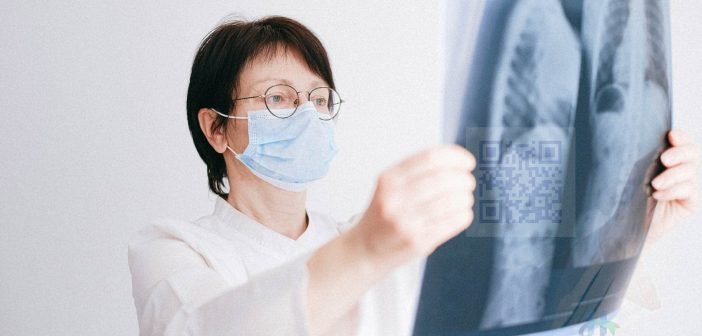Early-stage lung cancer often has no obvious symptoms. However, in some people, a cough that won’t go away, shortness of breath, hoarse voice… can be a warning signs of the disease.
Lung cancer may not cause any noticeable symptoms in its early stages, and many people are not diagnosed until the disease is advanced. But some early signs can be seen in some people. Lung cancer is the most common cancer and also the leading cause of cancer death in the world.
Despite great advances in early diagnosis and treatment, however, only about 19% of lung cancer patients, in general, have a survival time of ≥ 5 years at all stages of diagnosis. For stage 4, the 5-year survival time is very low, only about 2%.
Therefore, screening to detect the disease at an early stage is very important.
Here are 11 Early signs and symptoms of lung cancer. It should be noted that these symptoms may overlap with other conditions, many of which are very common and mild.
Table of Contents
Signs and symptoms of lung cancer
Lung Cancer Awareness has not been widely communicated. That is why many early symptoms go unnoticed leading to often late detection of lung cancer. The following article provides early symptoms and signs of lung cancer.
Cough that doesn’t go away or doesn’t change
You need to be on the lookout for a new, lingering cough. A cough caused by a cold or respiratory infection should go away in a week or so, but a persistent cough that persists could be a symptom of lung cancer. Also, pay attention to any changes in your chronic cough, especially if you smoke.

If you cough more often, cough deeper, or sound hoarse or cough up blood or have an unusual amount of mucus, it’s time to see your doctor.
Don’t try to get rid of a stubborn cough, whether it’s dry or mucus-producing. See your doctor right away. They will listen to your lungs and may order X-rays or other tests.
If a family member or friend experiences these changes, suggest that they contact a doctor.
Change in breathing or wheezing
Shortness of breath or becoming easy to breathe are also possible symptoms of lung cancer. Changes in breathing can occur if lung cancer blocks or narrows the airways, or if fluid from a lung tumor builds up in the chest.
Pay attention when you feel down or out of breath. If you feel short of breath after climbing stairs or performing tasks that you once found easy, don’t ignore it.
When your airways are constricted, blocked, or inflamed, your lungs may make a wheezing or hissing sound when you breathe. This can have many causes, some of which are benign and easy to treat.
However, wheezing is also a symptom of lung cancer, which is why it needs a doctor’s attention.
Human pain
Lung cancer can cause pain in the chest, shoulders, or back. The pain may not be related to the cough.
Tell your doctor if you notice any type of chest pain, whether sharp, dull, constant, or intermittent. You should also note whether it is limited to a specific area or occurs all over your chest.
When lung cancer causes chest pain, the discomfort may be due to enlarged or metastasized lymph nodes to the chest wall, the lining around the lungs, called the pleura, or the ribs.
Lung cancer that has spread to the bones can cause pain in the back or other areas of the body. Bone pain is often worse at night and increases with movement.
Headaches can be a sign that lung cancer has metastasized (spread) to the brain. However, not all headaches are associated with brain metastases.
Hoarse voice
If you hear a significant change in your voice or if someone indicates that your voice sounds deeper, hoarse, or hoarse, contact your doctor.
A simple cold can cause hoarseness, but this symptom could indicate something more serious as it lingers. Hoarseness associated with lung cancer can occur when the tumor affects the nerve that controls the larynx, or voice box.
Unexplained weight loss
Unexplained weight loss of 4kg or more may be related to lung cancer or another type of cancer.
When it comes to cancer, this weight loss can be attributed to the cancer cells using up energy. It can also be due to a change in the way the body uses energy from food.
Knowing the main symptoms of lung cancer can help with early detection and mean treatment is more likely to be successful. These symptoms could be caused by something much less serious than cancer. But they can be cancerous, so see your GP if you get them. Below is a video describing the symptoms and manifestations of lung cancer by Cancer Research UK
Symptoms of small cell lung cancer
Small cell lung cancer (SCLC) and non-small cell lung cancer (NSCLC) are the two main types of lung cancer. SCLC is less common than NSCLC but more aggressive.
SCLC often has no symptoms initially, but as it spreads in the lungs or to other parts of the body, you may experience the following:
- Bloody mucus.
- Shortness of breath or wheezing.
- Chest tightness.
- Persistent cough.
- Loss of appetite.
- Swollen face.
You should see your doctor right away if you have any of these symptoms.
What is the prognosis for small cell lung cancer?
Small cell lung cancer is rare, accounting for 10-15% of lung cancer patients, but the 5-year survival rate with this cancer is only about 6%, large cell lung cancer about 18%.
Lung cancer is divided into 2 main groups based on pathological characteristics: non-small cell lung cancer accounts for about 85% and small cell cancer accounts for 10-15%. These two histopathological types are fundamentally different in terms of treatment modality and disease prognosis.
Although less common, small cell cancers have a worse prognosis and are more difficult to treat. In fact, the 5-year survival rate with this type of cancer is only about 6%, with large cell lung cancer about 18%.
Currently, there are many treatments for lung cancer. In particular, small cell cancer is very sensitive to treatment with chemotherapy and radiation.
The most difficult problem is that the signs of lung cancer are atypical, so it is difficult to detect early. Late detection affects the effectiveness of treatment and affects the quality of life of patients.
Up to now, the cause of lung cancer is not clear, but about 90% of patients are due to smoking or exposure to secondhand smoke (passive smoking) for a long time. Smokers are 10 times more likely to develop cancer than non-smokers. If you smoke 20 cigarettes a day, your risk of lung cancer is 26 times higher than that of a non-smoker.
Worth mentioning, smokers have a 25% higher risk of developing small cell cancer than non-smokers.
Therefore, quit smoking, have regular health check-ups to promptly detect the risk of lung cancer, treat the disease at an early stage will have a better prognosis by detecting the disease at a late stage.
Who should be screened?
Currently, the American Society of Clinical Oncology and the National Cancer Network of the United States have recommended lung cancer screening for high-risk subjects who are 55-74 years old, with a smoking history of at least 30 pack-years, currently smoking, or have quit less than 15 years, in relatively good health.
Or people who are 50 years old or older, have a smoking history of at least 20 pack-years and have other risk factors such as passive smoking, family history, exposure to toxic smog, other common lung diseases such as chronic obstructive pulmonary disease…
For cases with moderate and low-risk factors, lung cancer screening is not recommended.
Cases with average risk factors were people aged 50 years or older, with a smoking history of at least 20 pack-years but no other risk factors.
Cases with low-risk factors are people under 50 years old, with a smoking history of fewer than 20 packs – years.
How to screen for lung cancer?
Screening for lung cancer with standard chest X-rays and sputum malignancy has been practiced since the 1940s. Studies at the time showed that cancer screening helped more cases to be diagnosed. diagnosis of lung cancer, an increase in the proportion of patients detected at an early stage, and a large proportion of patients with an early stage having a survival time of more than 5 years.
However, these methods have low sensitivity and specificity, that is, they are less able to detect cancer cases and easily miss patients with real lung cancer. Low-dose computed tomography is a currently preferred option for lung cancer screening.
Instead of having to use a high dose and take a long time like conventional computed tomography, low dose computed tomography uses only 0.15 mSv exposure within 15 seconds to complete a case and the ability to Its findings of a suspected malignancy in the lung was comparable to that of routine chest computed tomography. Currently, it is considered the standard method for lung cancer screening.
Regarding the role of cancer markers, in cancer in general and lung cancer in particular, cancer markers are essentially peptides secreted by cancer cells.
They are usually absent or present at very low concentrations in normal human serum. The abnormal presence of these substances in the serum can indicate the presence of a type of cancer in the body, thereby suggesting for doctors to combine other diagnostic measures to come up with a result. final argument.
However, even if these cancer markers are normal, the possibility of lung cancer cannot be ruled out. Therefore, the main purpose of cancer markers is to be a meaningful indicator in monitoring and evaluating the response of cancer to treatment measures, which plays a major role in disease prognosis. In lung cancer, commonly used tumor markers include CEA, Cyfra 21-1, SCC, NSE, Pro-GRP.
In recent years, scientists around the world are studying the role of microRNAs – a potential genetic material in the early diagnosis of cancers. However, its role in the early diagnosis of lung cancer needs time to be further evaluated.
How long does lung cancer live?
Anyone can get lung cancer, but smoking or exposure to secondhand smoke is linked to about 90% of lung cancer cases. According to the Centers for Disease Control and Prevention, smokers are 15 to 30 times more likely to develop lung cancer than non-smokers.
In the United States, about 7,300 never-smokers die from lung cancer each year from secondhand smoke.
Former smokers still have an increased risk of developing lung cancer, but quitting can significantly reduce that risk. Within 10 years of quitting, your risk of dying from lung cancer is cut in half.
Tobacco products contain more than 7,000 chemicals. At least 70 substances are known to cause cancer.
Once cancer enters the lymph nodes and bloodstream, it can spread anywhere in the body. Prognosis is better when treatment is started before cancer has spread outside the lungs.
Other factors that affect the prognosis of the disease include your age, overall health, and how well you respond to treatment. Because early symptoms can be easily missed, lung cancer is often diagnosed at a later stage.
In recent years, new treatments have been approved for stage 4 non-small cell lung cancer (NSCLC). Some people survive much longer than with previous traditional treatments. The 5-year survival rate for distant metastases is 6% when cancer has spread to nearby lymph nodes, tissues, and organs are 33%, and when the cancer is confined to the site of origin, there are no signs of spreading, this rate is up to 60%.
In contrast, small cell lung cancer (SCLC) is very malignant. For limited-stage SCLC, the 5-year survival rate is 14%. Median survival is 16 to 24 months. Median survival for extensive metastatic SCLC is 6 to 12 months.
Without treatment, the median survival time from SCLC diagnosis is only 2 to 4 months.
Symptoms of late-stage lung cancer
Like many other cancers, lung cancer can also cause systemic symptoms, such as loss of appetite or general fatigue. Most lung cancers do not cause symptoms until the disease is advanced, in part because the lungs have few nerve endings.
Advanced stages of lung cancer are often characterized by the spread of cancer to distant sites in the body. This can affect the bones, liver, or brain. When other parts of the body are affected, new lung cancer symptoms may develop, including:
- Bone pain.
- Swelling of the face, arms, or neck.
- Headache, dizziness or weakness, or numbness in the limbs.
- Jaundice.
Tumor in the neck or collarbone area.
Scientists have found that less than 10% of cancers arise from internal disorders that are often irreversible. In contrast, more than 80% of cancers arise due to modifiable factors.
Specifics include:
Tobacco: Smoking, including passive smoking, is one of the leading risk factors for lung cancer. Many studies surveying patients with lung cancer have shown that 90% of people suffer from smoking-related problems, 24% of people suffer from passive smoking.
- Unhealthy diet.
- Environmental pollution, waste from engines, smoke, radioactive substances…
- Pre-existing chronic diseases in the lungs: tuberculosis, calcified nodules, old scar lesions in the lungs, chronic pneumonia with metaplasia.
Lung cancer is also classified as difficult to detect early. Therefore, disease prevention is considered the most important strategy. Accordingly, people do not smoke, stay away from secondhand smoke, improve industrial hygiene and avoid exposure to smog, and go for regular health check-ups.
For people over 50, doctors recommend lung cancer screening every 6 months – 1 year. Especially for people who smoke or smoke a lot, they should go for screening earlier.

